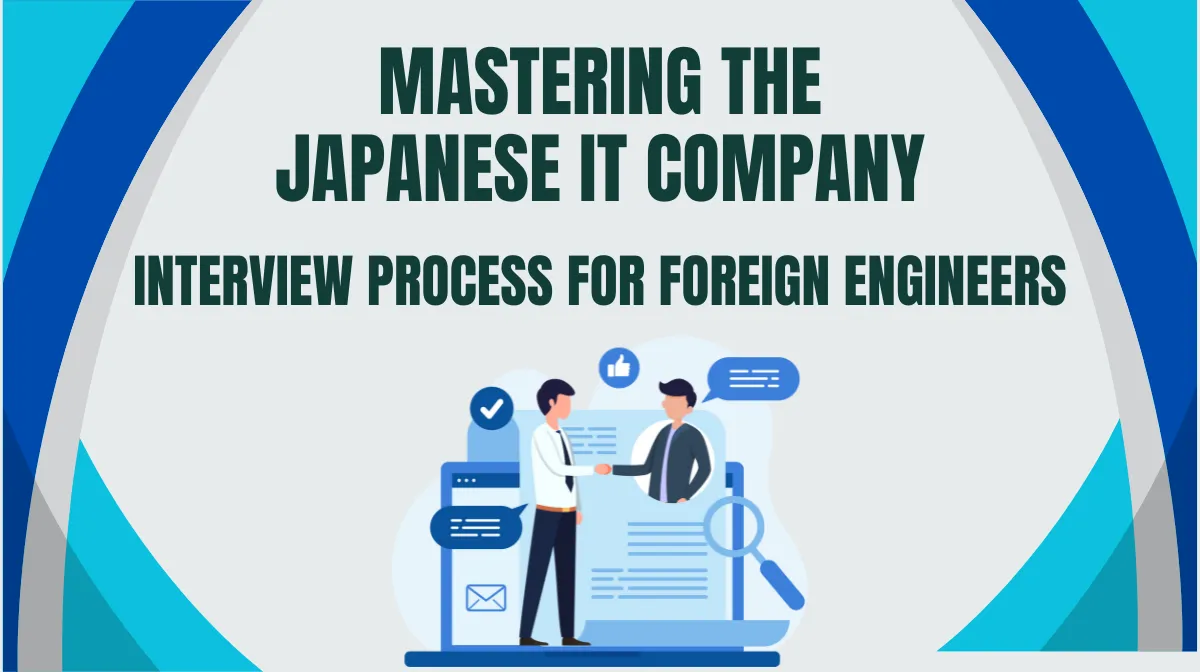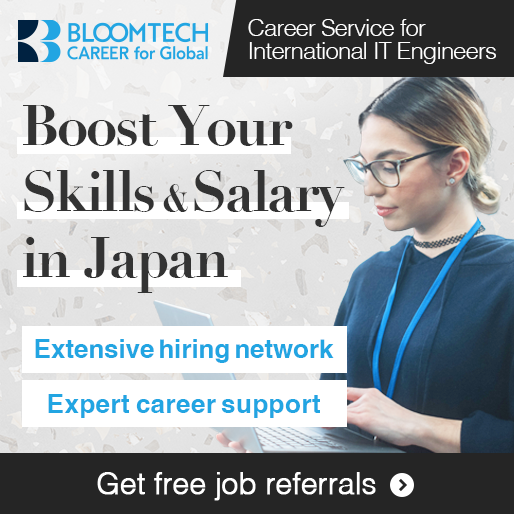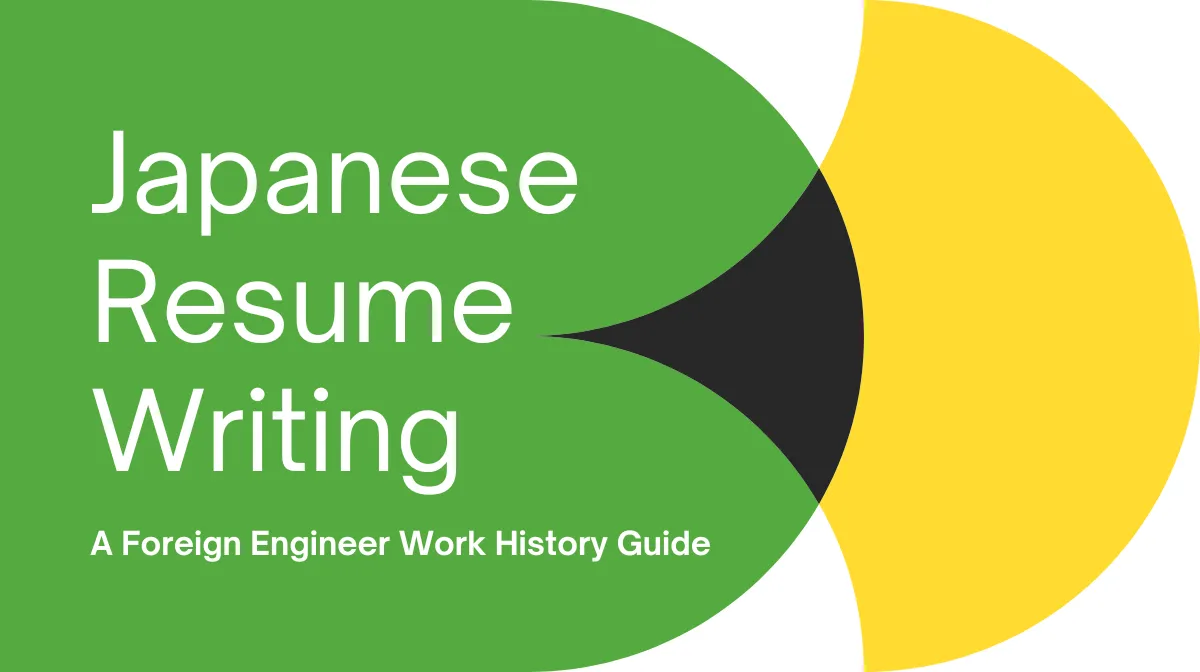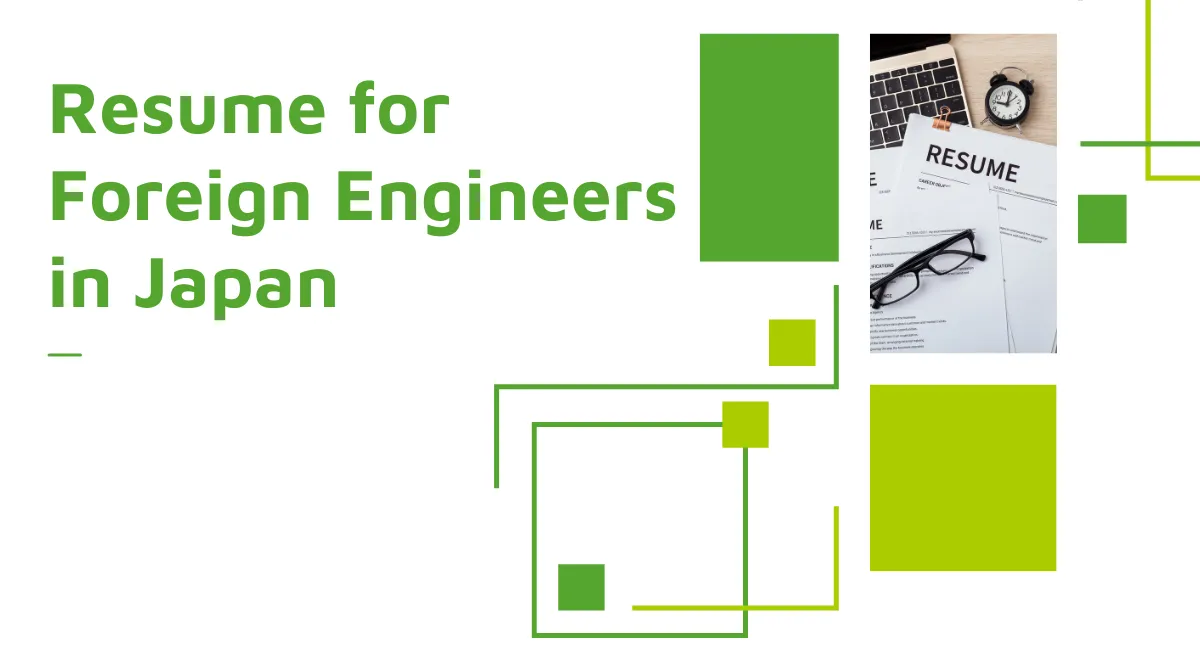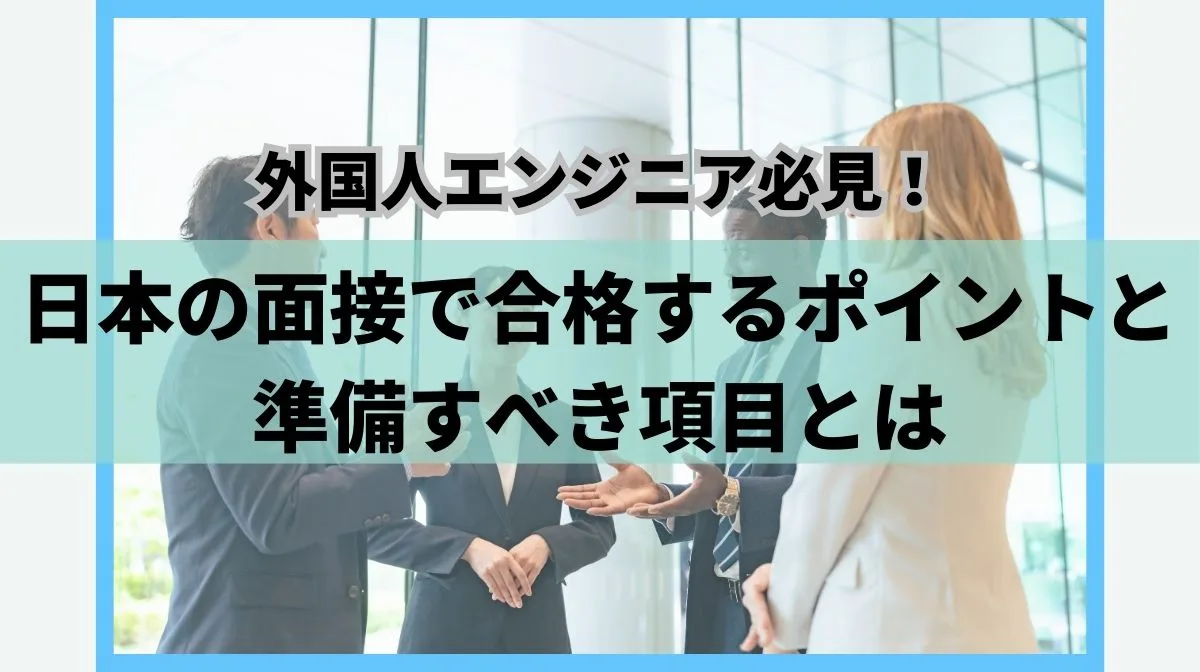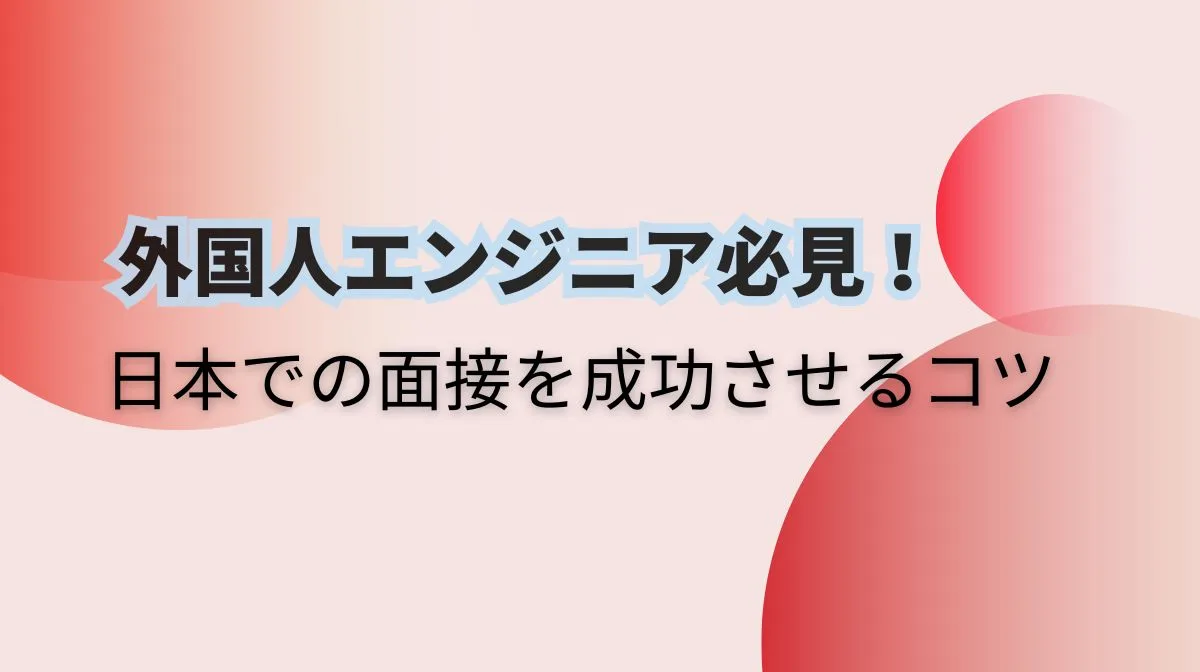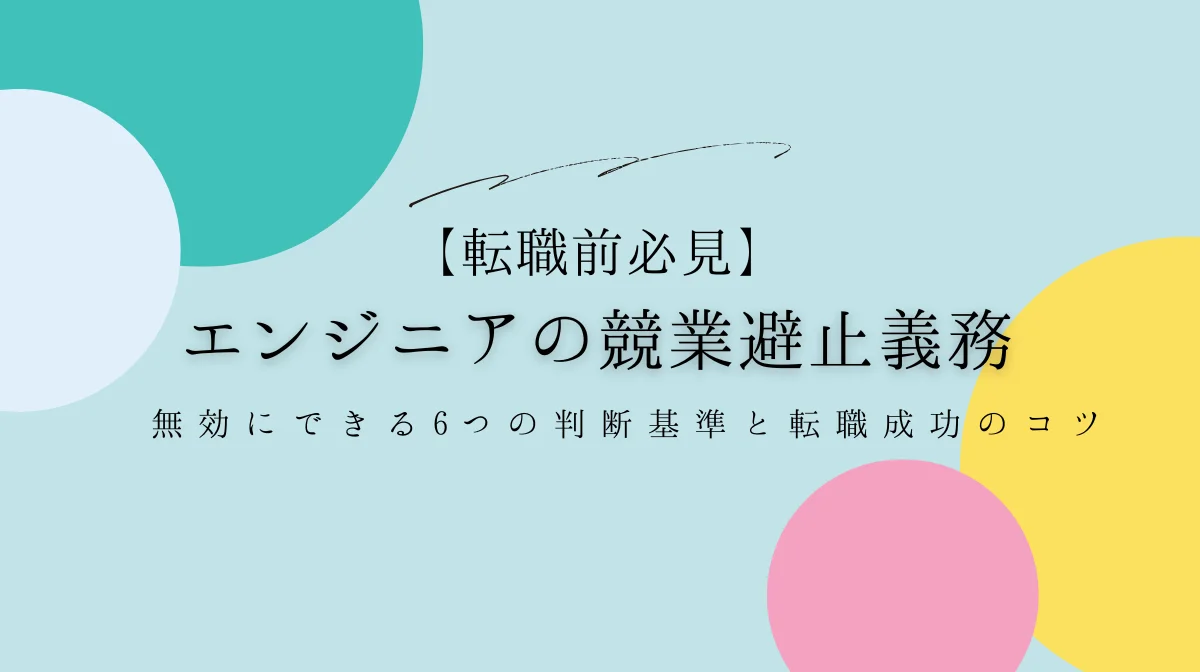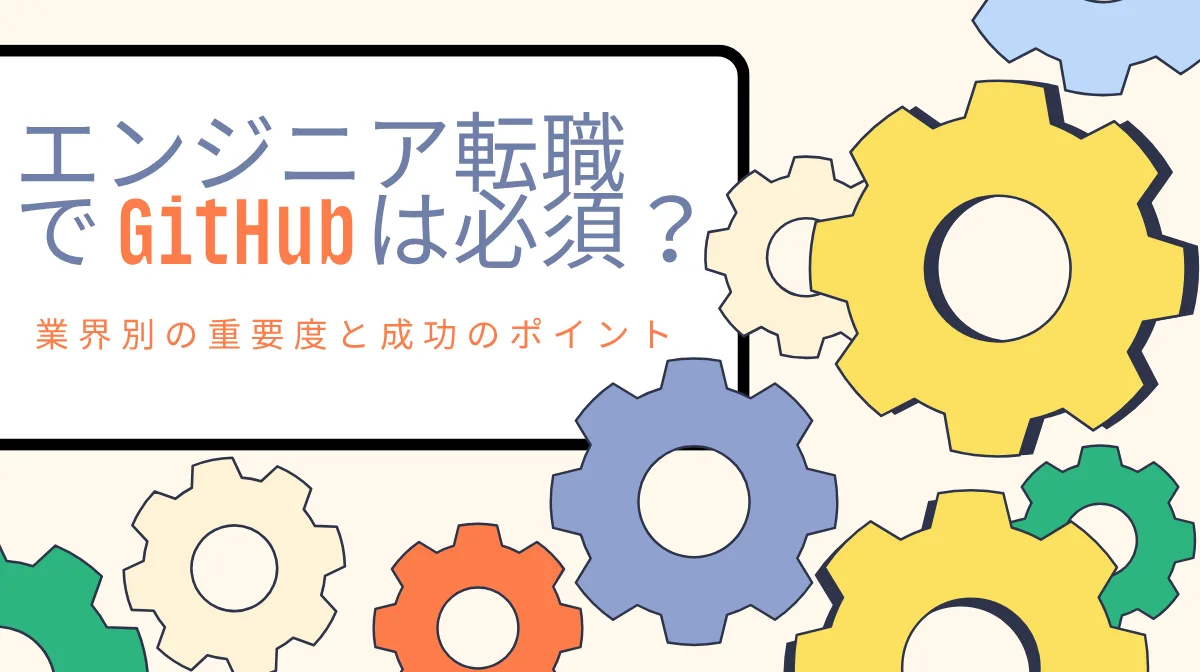For IT engineers looking to change jobs successfully, interviews are an unavoidable part of the process. Japanese IT companies in particular value not only technical skills but also communication abilities and team fit.
This article will explain in detail the basic flow of interviews at Japanese IT companies, seven key preparation points for success, and common failure patterns, providing practical advice throughout.
We hope this will be helpful for foreign IT engineers preparing for interviews.
- The stages of Japanese IT interviews from screening to job offer.
- How to showcase both technical skills and cultural fit.
- Essential preparation strategies for foreign engineers.
1. Understanding the Basic Flow of Japanese IT Company Interviews

While interview processes vary by company, understanding the basic flow will help you prepare mentally.
By grasping the overall picture of the hiring process and knowing what is evaluated at each stage, you can prepare more effectively.
From Document Screening to Job Offer: General Steps
The selection process at Japanese IT companies typically follows this flow
- Document screening
Your resume and work history are carefully reviewed. Technical achievements such as GitHub portfolios are highly valued, so be sure to include specific accomplishments and technical skills in your documents. - First interview (after passing document screening)
Initial meeting with HR or recruitment staff. Basic suitability and communication skills are evaluated here. - Technical interview
Meeting with engineers or technical managers who will delve deeply into your technical skills and practical experience. In some cases, programming tests or coding challenges may be given. - Final interview
Meeting with business leaders or executives for final suitability assessment. - After passing selection
You’ll receive an official job offer, and after accepting, you’ll proceed with submitting necessary documents and other preparations for joining the company. The selection period varies by company, but typically takes about 1-2 months. If you’re applying to multiple companies simultaneously, schedule management becomes important.
Purpose and Differences Between First, Technical, and Final Interviews
Each interview stage has distinct objectives.
Preparation tailored to each interview stage is necessary, with special attention to the technical interview where you should be prepared to explain your specific experiences and skills.
◆First interview
- Basic personality assessment
- Communication skills verification
- Confirmation of application motivation and reasons for changing jobs
- Initial evaluation of career direction and company fit
- Basic business etiquette check, etc.
◆Technical interview
- In-depth verification of specialized technical skills
- Detailed examination of practical experience and project history
- Evaluation of problem-solving abilities and technical thought processes
- Assessment of technical suitability, including ability to work with the team, etc.
◆Final interview
- Hiring decision from management perspective
- Final confirmation of fit with company culture
- Verification of alignment between long-term career outlook and company vision
- Final adjustment of compensation and conditions, etc.
Japan-Specific Interview Processes and Differences from Overseas
Japanese IT company interview processes have characteristics that differ from global companies.
Japanese Company Characteristics
- Tendency to emphasize multiple rounds of interviews, with 3-4 interviews being common
- Equal emphasis on personality and team fit as on technical skills
- Questions may be indirect with a need to understand “implicit understanding”
- Many questions confirm long-term commitment, with detailed inquiries about reasons for changing jobs. Additionally, time for asking your own questions is always provided
- Appearance and etiquette are also often evaluation factors
Differences from Overseas Companies
Overseas companies tend to place greater weight on technical interviews and coding tests. While Japanese companies may consider “potential hiring,” foreign companies tend to focus more on immediate readiness.
2. What Japanese IT Company Interviewers Are Looking For

In IT company interviews, various aspects beyond technical skills are evaluated. Understanding what interviewers are looking for and appropriately highlighting your strengths is key to securing a job offer.
Knowing the multifaceted evaluation perspective will help you effectively communicate your strengths.
Five Elements Evaluated Beyond Technical Skills
IT company interviewers comprehensively evaluate five elements.
- Technical skills and specialized knowledge
- Communication ability
- Problem-solving ability and logical thinking
- Learning motivation and growth potential
- Teamwork and cultural fit
It’s important to balance highlighting these elements in IT company interviews.
Technical skills and specialized knowledge
Understanding of programming languages and frameworks, system design concepts and experience, troubleshooting abilities, and adaptability to new technologies are checked
Communication ability
Ability to explain technical content clearly, team information sharing skills, communication with clients and non-technical staff, ability to accurately understand questions and respond appropriately
Problem-solving ability and logical thinking
Analytical skills and solution approaches for tasks, response to unexpected situations, ability to derive efficient solutions
Learning motivation and growth potential
Curiosity and motivation to learn new technologies, self-development efforts, clarity of career vision and actions toward realization
Teamwork and cultural fit
Cooperation and respect for others, flexibility in accepting diverse opinions, compatibility with company values and work style
Reasons for Checking Compatibility with Company Culture
Interviewers emphasize cultural fit for several reasons: improving team productivity, increasing retention rates, fostering long-term growth and contribution, and maintaining a collaborative workplace environment.
Teams composed of members with aligned values have smoother communication and higher productivity, while those who don’t fit the corporate culture risk early resignation.
Additionally, when company direction aligns with individual career aspirations, mutual growth becomes possible. Cultural compatibility is especially key in environments where team collaboration is important, such as agile development or scrum.
Tips for Interpreting Interviewers’ Questions
Interview questions often have deeper intentions beyond their surface meaning. Understanding these intentions allows you to respond more appropriately.
Understanding Question Categories
Skill confirmation questions
“Do you have experience with XX?” etc. Verifying depth of technical skills.
Behavioral questions
“How did you overcome difficult situations?” etc. Assessing problem-solving abilities and persistence.
Value questions
“What’s your ideal work environment?” etc. Checking cultural fit.
Considering Concerns Behind Questions
Retention rate concerns
“Why have you changed jobs so frequently?” etc.
Looking for attitude toward learning from failures and honesty
“What failures have you experienced in this project?” etc.
Confirming autonomy and time management skills
“What do you think about remote work?” etc.
Noting Question Patterns
Particularly emphasized themes
When the same topic is repeatedly asked from different angles
Possibly checking for balance
When questions suddenly shift from technical to interpersonal
Potential workplace scenarios
When presented with a specific scenario and asked “What would you do?”
■日本でエンジニアとしてキャリアアップしたい方へ
海外エンジニア転職支援サービス『 Bloomtech Career 』にご相談ください。「英語OK」「ビザサポートあり」「高年収企業」など、外国人エンジニア向けの求人を多数掲載。専任のキャリアアドバイザーが、あなたのスキル・希望に合った最適な日本企業をご紹介します。
▼簡単・無料!30秒で登録完了!まずはお気軽にご連絡ください!
Bloomtech Careerに無料相談してみる
3. Preparation Point 1: Self-Analysis and Organizing Your Strengths

The first step to interview success is deeply understanding yourself and being able to clearly communicate your strengths.
It’s essential to organize your specialties and experiences as an IT engineer to make an impression on interviewers. Objectively analyze your strengths and weaknesses, and learn how to convey them persuasively.
Methods for Effectively Highlighting Technical Skills
To effectively highlight technical skills, it’s important not only to list skills but also to systematically organize them and prepare specific examples.
Create a skills matrix
Organize skills by category: languages/frameworks, middleware/infrastructure, development methods/tools, etc. Self-evaluate each with levels such as “practical experience” “mastery” or “self-taught/basic knowledge only”
Organize specific usage records
For each skill, organize when, in what kind of project, how you used it, achievements, and challenges solved. Additionally, organizing how your skill set relates to industry trends can be effective.
When highlighting
Communicate at an appropriate level, demonstrate balance between technical depth and breadth, include metrics and specific achievements, and explain the reasoning behind technical decisions.
Framework for Structuring Project Experience Explanations
To effectively convey project experience, using a systematic framework is useful. The STAR method is representative: Situation, Task, Action, and Result.
Example for participating in an EC site performance improvement project
“I participated in an EC site performance improvement project (S). I was responsible for backend performance analysis and improvement (T). First, I conducted load testing to identify problem areas, then optimized database queries and implemented caching mechanisms. Specifically, I implemented batch processing to solve N+1 problems and improved session management efficiency through Redis implementation (A). As a result, peak response time improved by 50%, and server costs were reduced by about 20% annually (R).”
Methods for Maintaining Consistency in Job Change Reasons and Motivations
It’s extremely important to explain your reasons for changing jobs and your motivations with consistency. Contradictory explanations damage credibility and reduce chances of being hired.
Points to check for consistency include whether your job change reason and motivation are logically connected, whether there are contradictions between your resume content and interview explanations, and whether your long-term career vision is included.
Clearly Define “Push Factors” and “Pull Factors”
Push factors are reasons for leaving your current position (career stagnation, limitations in technical growth, etc.), while pull factors are reasons attracting you to the target company (technical environment, business domain, corporate culture, etc.).
Create a Storyline
Develop a flow: “Current situation → challenges or limitations → future vision → why the target company is optimal for realization” Also, avoid negative expressions: transform “poor human relationships” → “want to perform in a more collaborative environment,” “low salary” → “seeking evaluation commensurate with skills and responsibilities”
Connect Company Characteristics with Your Values and Career Goals
Link the company’s technology stack with your expertise/interests, the company’s business domain with your potential contributions, and the company culture with your work style compatibility.
4. Preparation Point 2: Thorough Company Research

Thorough research on your target company is essential for interview success.
Knowledge gained through company research helps build appropriate motivation, answer questions, and prepare reverse questions. Understanding the company from multiple perspectives, from technology stack to corporate culture, will clarify compatibility and potential contributions.
Methods for Collecting Information on IT Companies’ Technology Stacks and Projects
Understanding a company’s technical aspects is important to prevent mismatches and clarify how you can apply your skills.
For collecting technical information, first check the official website and engineering blog. Review the company’s technical blog, developer pages, GitHub or open-source contributions, and technical event presentation materials.
Analyzing recruitment information is also effective. Examine required and preferred skills in job listings, technology stack introductions on recruitment pages, and technical questions asked in past interviews.
Additionally, social media and community information can be valuable, such as posts by company engineers on Twitter/X, LinkedIn, Qiita, and activities of company engineers on Stack Overflow.
Main Technical Information to Collect
- Primary development languages and frameworks
- Infrastructure environment (on-premises/cloud, services used)
- Development methodologies (agile, waterfall, etc.)
- Team composition and role distribution
- Technical challenges and innovations being addressed
How to Understand and Apply Corporate Philosophy and Culture in Interviews
Understanding a company’s philosophy and culture, not just its technical aspects, is key to interview success.
This understanding is particularly important for demonstrating “cultural fit” with Japanese companies that value it.
Methods for Collecting Corporate Culture Information
Check official information: Mission, vision, value statements; messages or lectures from founders or executives; company history; CSR and SDG initiatives. Also important is understanding the internal atmosphere: employee interviews, internal events, office environment photos or videos, and work style policies. Additionally, check external evaluations: employee voices on review sites, media coverage, and industry reputation.
In interviews, leverage this information by identifying commonalities between your values and the company culture and preparing specific episodes to demonstrate empathy, naturally incorporating words and concepts the company values.
Preparing Differentiating Questions Based on Industry Trends
The IT industry changes rapidly, and demonstrating understanding of the latest trends and challenges showcases your market value and learning motivation.
Methods for Industry Trend Information Collection
Understand technology trends through industry predictions like Gartner’s Hype Cycle, GitHub Trends, Stack Overflow Survey, notable themes at major conferences
Understand business trends
Progress of DX and digitalization, industry-specific challenges (e.g., security requirements in the financial industry), regulatory changes (e.g., Personal Information Protection Law amendments)
Analyze competitive environment
Target company’s main competitors and their movements, market share and growth rate comparisons, understanding of differentiating factors
Example Questions Based on This Information
Questions about company strategy
“How is your company considering using or responding to recent AI technologies?” “Cloud-native development is becoming mainstream in the industry; what are your company’s system renewal plans?”
Questions about technology selection
“I understand you’ve adopted microservice architecture; what challenges did you face transitioning from monolithic design, and how did you overcome them?”
Questions about organization
“With the increase in remote work, how do you innovate knowledge sharing and collaboration among engineers?”
■日本でエンジニアとしてキャリアアップしたい方へ
海外エンジニア転職支援サービス『 Bloomtech Career 』にご相談ください。「英語OK」「ビザサポートあり」「高年収企業」など、外国人エンジニア向けの求人を多数掲載。専任のキャリアアドバイザーが、あなたのスキル・希望に合った最適な日本企業をご紹介します。
▼簡単・無料!30秒で登録完了!まずはお気軽にご連絡ください!
Bloomtech Careerに無料相談してみる
5. Preparation Point 3: Preparing Answers to Common Questions

Interviews often include fairly predictable questions.
Preparing specific and persuasive answers to these questions allows you to approach interviews with confidence.
Understand common question patterns and effective response methods, from technical questions to career-related ones.
Technical Question Patterns and Effective Response Methods
Various technical questions are posed in IT company interviews.
Common Technical Question Patterns
Questions testing understanding of basic concepts
“Please explain the characteristics of object-oriented programming,” “What is a RESTful API?” “Please explain MVC architecture,” etc.
Questions exploring practical experience
“What frameworks have you used and why did you select them?” “What was your most difficult technical challenge and how did you solve it?” “What did you do to maintain code quality in your team?” etc.
Questions examining problem-solving abilities
“What’s the problem with this code? How would you improve it?” “How would you identify the cause if system performance decreased?” “What measures would you take to minimize security risks?” etc.
Questions testing understanding of latest technologies
“What do you think about container technology?” “What are the advantages and disadvantages of microservice architecture?” “Do you have experience incorporating AI or machine learning into projects?” etc.
Effective Response Points
Utilize the STAR method, provide specific examples, balance appropriate use of technical terms with plain language explanations, connect responses to your strengths, honestly communicate your knowledge level, and express continuous learning attitudes.
Reference: HAYS: What is the STAR technique
Points for Convincingly Communicating Career Vision
Questions about career vision invariably arise in interviews.
It’s important to prepare multifaceted, concrete, and persuasive answers to questions like “What kind of engineer do you want to become?” or “Where do you see yourself in five years?”
Points for Communicating Career Vision
Envision specific and realistic visions. For example, “In three years, I want to take on a team leader role as an AI engineer and be involved in launching new services” or “In the future, I want to contribute to solving customer problems as a solution architect”
Clearly connect with the target company
Explain how your career vision aligns with the company’s business policies or growth strategies. Additionally, recognize gaps with your current skill set and show an action plan to fill those gaps for added persuasiveness.
Show flexibility
While maintaining a clear vision, demonstrate willingness to “adapt flexibly to changing situations.” Especially in the rapidly changing IT industry, overly fixed career plans may be judged unrealistic.
Response Techniques for Converting Weaknesses to Strengths
“What is your weakness?” is a common interview question. For this question, it’s important not just to state weaknesses but to show efforts to overcome them and, in some cases, methods to convert them into strengths.
Basic Approach to Converting Weaknesses to Strengths
An effective flow is to honestly recognize your weakness, show specific actions to improve it, and emphasize growth and learning gained in the process.
Example: If you mention “Sometimes I focus too much on details and work becomes slower” as a weakness, you might continue, “Since recognizing this tendency, I’ve been improving efficiency by prioritizing tasks and setting time boxes. Also, this attention to detail becomes a strength in quality control and has led to early detection of critical bugs in past projects.”
This explains the flow: weakness recognition → improvement action → conversion to strength.
6. Preparation Point 4: Mastering Interview Etiquette

In interviews, not only technical skills and abilities but also basic manners and behavior are important evaluation points.
Japanese IT companies in particular value teamwork and basic professional qualities when working in teams, so acquiring appropriate manners can make a good impression.
Behavior to Make a Good First Impression in On-Site Interviews
First impressions in on-site interviews significantly influence the overall interview evaluation.
◆Arrival at the interview venue
Arriving at the interview venue not too early or late, about 10 minutes before is ideal. At reception, politely state your name and purpose: “I have an interview scheduled at XX o’clock. My name is XX”
◆Waiting room to entry
Sit with good posture in the waiting room and avoid speaking loudly. When entering the interview room, knock and say “Excuse me,” and bow politely upon entering. After the interviewer’s invitation, greet them with “Thank you for this opportunity” and maintain a standing posture until prompted to sit. When seated, sit on about the front third of the chair with a straight back. When speaking, look at the interviewer and speak with a bright, clear voice.
◆Answer questions
Answer questions concisely starting with the conclusion, supplementing with specific examples as needed. Avoid overly long answers; aim for about 2-3 minutes per question response. If asked something you don’t know, honestly answer, “I’m sorry, I’m not familiar with that point, but I would like to learn about it.”
◆End of the interview
At the end of the interview, express gratitude: “Thank you for your time today” and bow politely. When exiting, add a parting “Excuse me.”
◆Other points
All actions from entering the company building until leaving may be subject to evaluation. Be polite to receptionists and employees you meet in elevators.
Environment Setup and Considerations for Online Interviews
Online interviews require different preparation and considerations than face-to-face interviews.
Preparation Points
Technical aspects
Install and test the video conferencing tool at least one day before the interview. Checking camera and microphone operation is essential, and having a backup mobile phone or tablet is recommended.
Environment setup
Choose a quiet, well-lit, organized space. Use a simple wall or virtual background. Adjust the camera position to eye level, ensuring your upper body appears balanced on screen.
Attire
Clean business casual or suit appropriate as for in-person interviews. Choose subdued colors.
Be ready to enter the meeting room about 5 minutes before the interview start time, entering at the scheduled time.
Points to Note
Consider communication delays and pause slightly after the interviewer speaks before beginning your response, pay attention to posture and facial expressions even online. If taking notes, add a comment like “I’ll take some notes if that’s alright.”
At the end of the interview, express gratitude: “Thank you for your time today” and don’t disconnect until instructed by the interviewer.
Have the company contact’s details (email address or phone number) ready in case of technical issues.
7. Preparation Point 5: Preparing Reverse Questions

At the end of the interview, you’ll always have the opportunity to ask questions with “Do you have any questions?”
Rather than treating this as a mere formality, consider it an excellent opportunity to demonstrate your enthusiasm and suitability. It’s important to prepare quality questions in advance.
Questions That Demonstrate Technical Skills and Motivation
Reverse questions are not just for gathering information but an important opportunity to showcase your technical interests and growth motivation.
Questions like the following demonstrate technical skills and growth motivation:
Example Questions
Demonstrating quality management awareness and learning motivation
“How do your engineering teams conduct code reviews and knowledge sharing?”
Showing technical insight and interest in problem-solving
“What is the most technically challenging issue in the projects you’re currently working on?”
Showing interest in thought processes for technology selection
“What process do you use for deciding to adopt new technologies?”
Demonstrating continuous learning and growth motivation
“What initiatives or systems do you have for enhancing engineers’ technical skills?”
Showing long-term perspective and understanding of technology trends
“What technical areas will your company focus on over the next 3-5 years?”
Question Methods to Demonstrate Company Understanding While Extracting Information
Reverse questions are also opportunities to extract deeper information based on thorough company research.
Showing your understanding of the company while asking questions conveys genuine interest.
The basics of questions demonstrating company understanding is to base them on public information while asking for insights that go a step deeper.
For example, “I saw the XX project on your company blog; what were the key points in technology selection for this project?” Starting with reference to public information demonstrates your company research.
Prefacing questions with “My understanding is…” shows your company understanding while creating opportunities for correction or deeper exploration.
Skillfully weaving in information gained through company research demonstrates high interest and information gathering abilities.
Reverse Question Patterns to Absolutely Avoid
Reverse questions are crucial opportunities that can determine your impression, so it’s important to know question patterns to avoid.
First to avoid is answering “I don’t have any questions” This may be perceived as lack of preparation or interest.
Even if you can’t think of anything, have some general questions prepared, such as “What qualities are most sought after in engineers working at your company?”
Other Questions to Avoid
Basic questions easily found in public information
“What are your company’s main services?” “When was the company established?” Such questions give the impression you haven’t done company research.
Questions that appear solely focused on your benefit
“What’s the salary?” “Is there a lot of overtime?” “What about holidays and benefits?”
Questions rushing selection results
“What are my chances of being hired?” “When will I hear the results?” Only ask about selection schedule if the interviewer doesn’t explain, politely asking “Could you tell me about the next steps in the selection process?”
Critical questions about the company or industry
“Why is your market share declining?”
Questions giving negative impressions
“Can I work remotely?” “Are transfers infrequent?” These suggest you’re seeking conditions or constraints before even joining.
8. Preparation Point 6: Developing Practical Skills Through Mock Interviews

The most effective interview preparation is conducting mock interviews.
Practicing in an environment similar to the real thing helps develop comprehensive practical skills, including not just response content but also facial expressions, voice tone, and posture.
Effective Mock Interview Implementation Methods
To conduct effective mock interviews, it’s important to recreate an environment as close as possible to the real situation.
First, ask a trusted collaborator (friend, family member, job placement agent) to play the interviewer role, ideally someone with actual interview experience.
Set up the environment similar to an actual interview. For online interview practice, use the tools you plan to use; for in-person interviews, arrange the room setup to simulate the real experience.
Wear the same attire as for the actual interview and record with a camera or smartphone to objectively check your demeanor afterward.
If using a recruitment agent, utilizing their mock interview service can be effective.
This not only provides professional feedback but may also include insights on the target company’s interview tendencies and points to note.
Training to Improve Explanation Skills in Technical Interviews
In technical interviews, the ability to clearly explain your knowledge is required, not just having the knowledge itself.
The skill to concisely and logically convey complex technical concepts or past project experiences significantly enhances your value as an engineer.
Using methods like PREP (Point-Reason-Example-Point) and being conscious of balancing technical terms with plain language is important.
It’s good to practice adjusting the level of detail and terminology based on the interviewer’s technical background.
In technical interview explanations, balancing theory and practice is important. Being able to explain “why you chose that technology,” “what challenges arose and how you solved them” from a practical perspective demonstrates application skills beyond just listing knowledge.
Cycle of Using Feedback for Improvement
Effectively utilizing feedback from mock interviews and continuously improving is key to interview success. Specific steps for utilizing feedback are as follows…
- Objectively accept feedback
- Prioritize and establish an improvement plan with concrete goals
- Create and execute an action plan
Conduct another mock interview to verify improved points. Including the same questions as the previous mock interview allows direct comparison of improvement effects.
Repeating this cycle enables steady skill development.
9. Preparation Point 7: Mindset and Adaptability on Interview Day

No matter how much preparation you do, it’s natural to feel nervous on interview day. To perform well under such conditions, having the right mindset and ability to respond to unexpected situations is important.
Develop the mindset and specific techniques to respond calmly during the actual interview.
Mindset Techniques for Making Nervousness Your Ally
Pre-interview nervousness is a natural reaction, and moderate tension can actually enhance concentration and improve performance.
Rather than trying to suppress nervousness excessively, learn mindset techniques to transform it into positive energy.
A specific effective mindset technique is “reframing.” Replace the state of “being nervous” with positive words like “being focused” and tell yourself this.
Also, being released from “perfectionism” is important. The belief that “I absolutely cannot fail” amplifies nervousness.
Instead, reframe the interview as “an opportunity to honestly convey my experiences and strengths.”
Handling Unexpected Questions
No matter how well prepared you are, unexpected or difficult questions may arise. Learn methods to respond calmly without panicking in such situations.
First, it’s important to understand the question accurately. If the intention is unclear, politely ask, “May I confirm the intent of your question?”
Rephrasing the question for confirmation deepens understanding while also buying thinking time.
If unsure about how to answer, have the courage to say, “Let me think about that for a moment.”
A thoughtful response after a brief pause is more favorable than an impulsive answer out of fear of silence. However, it’s advisable to avoid silences lasting more than 30 seconds.
For technical questions where you lack knowledge, honesty is important.
“I’m sorry, I’m not familiar with that technology, but I’m eager to learn” is a good approach, followed by mentioning related knowledge or similar experiences if possible.
Methods to Leave a Good Impression with Post-Interview Follow-up
An interview doesn’t end when you leave the room. Appropriate follow-up can strengthen your positive impression and increase hiring possibilities.
Sending a thank-you email within 24 hours after the interview is effective. Express gratitude for the opportunity, concisely reconfirm content discussed, and your strengths.
Keep this email short, concise, and with polite language.
Thank-You Email Example
“Thank you for your valuable time today. Learning about your company’s efforts with microservice architecture and the culture supporting engineer growth has increased my motivation to join. I particularly feel I could contribute to the XX project with my past experience. I look forward to hearing from you.”
10. Common Failure Patterns in Japanese IT Company Interviews and Countermeasures

The reasons for missing out on job offers aren’t limited to lack of ability. There are cases where excellent skills and experience don’t result in hiring due to specific failure patterns.
Here we explain common failure patterns in Japanese IT company interviews and their countermeasures.
Cases of Rejection Due to Overemphasis on Technical Skills
While showcasing technical skills is certainly important in IT engineer interviews, overemphasizing them at the expense of other elements can prevent you from being evaluated as a balanced engineer.
Japanese companies in particular value teamwork and cooperation, so an one-sided technical appeal can be counterproductive.
Examples of Technical Skill Bias
- Continuing excessively detailed technical explanations beyond what was asked
- Speaking as if showing off specialized knowledge
- Describing team achievements as if they were solely your own accomplishments
To prevent this failure, first aim to keep technical explanations concise, adding details as needed.
An effective approach is to “first state the conclusion concisely, then delve into details based on the interviewer’s reaction.”
Additionally, actively highlight team roles and collaborative experiences.
Explanations like “Through close coordination between my backend development and the frontend team, we smoothly implemented API specification changes and achieved release on schedule” demonstrate not just technical skills but qualities as a team player.
Patterns of Creating Misunderstandings Due to Communication Shortfalls
Even with high technical skills, you may not be hired if there are communication challenges.
Japanese IT companies value not only technical communication but also the ability to build smooth human relationships.
Typical Failure Patterns Due to Communication Shortfalls
- Giving irrelevant answers without accurately understanding question intent
- Using excessive specialized terms or abbreviations that interviewers can’t understand
- Speaking continuously without observing interviewer reactions
- Speaking too softly or quickly, making communication difficult
- Insufficient non-verbal communication (facial expressions, posture, eye contact, etc.)
To prevent this failure, prioritize accurately understanding question intent.
If unclear, confirm with “Is your question about XX?” Repeating the question for confirmation prevents misunderstandings and clarifies response direction.
Basically, aim for explanations understandable to people with different technical backgrounds.
Additionally, pay attention to voice volume, speed, and clarity. While nervousness tends to make speech faster, consciously try to speak slowly and clearly.
This is especially important in online interviews where communication environment effects are also a factor.
11. Post-Interview Process to Job Offer and Points to Note

Even after completing interviews, there are several steps to receiving a job offer, each requiring appropriate responses.
Behavior at this stage can also influence final hiring decisions, so it’s important to understand this well.
General Flow from Job Offer Notification to Starting Work
After passing selection, you’ll receive a job offer from the company.
While processes vary by company, understanding the general flow helps proceed smoothly.
Job offer notification formats include verbal (telephone) notification, email notification, and sending an official offer letter. When receiving a job offer, first confirm receipt and express gratitude within 24 hours.
Consideration periods for accepting offers are typically set at 1-2 weeks. If you have offers from multiple companies or other selections in progress, you’ll need to decide within this period.
When accepting an offer, contact the person in charge by phone or email, then submit formal documents like an acceptance letter.
After accepting the offer, specific procedures for joining begin. Typically required are submission of necessary documents (residence certificate, pension book, bank account information, etc.), health examination, agreement to various regulations, etc.
Additionally, specific conditions like start date, assignment, and starting salary are formally presented.
As the start date approaches, reconfirm what to bring and the meeting time/place to prepare for the first day. First impressions are important, so on your first day, take care with appearance as you did for the interview and aim to act with ample time to spare.
Timing and Effective Approaches for Salary Negotiations
While salary negotiation is more challenging in Japanese IT companies compared to Western ones, appropriate timing and methods can potentially secure conditions closer to your wishes.
Best Timing for Salary Negotiation
During the final selection stage or immediately after receiving an offer. Negotiating power increases especially when you have offers from multiple companies. Avoid too-early negotiations (like first interviews) and conduct them when the company wants you.
Negotiation Premise
Understanding market value is important. Research the going rate for engineers with similar skill sets and experience. Salary range data from job sites, information from recruitment agents, information exchange with colleagues in the same field form the foundation for negotiation.
During Negotiation
Rather than just “wanting more,” it’s important to explain why you provide value worth that amount. For example, “I have 3 years of practical experience with XX technology and believe I can contribute immediately to your projects. In my previous position, I contributed to a 30% increase in sales through similar system development.” Such concrete value propositions are persuasive.
How to Handle and Maintain Etiquette with Multiple Job Offers
Receiving multiple job offers during job searching is a good situation that broadens your options.
However, handling them requires certain etiquette and strategy. Here’s how to handle multiple job offers effectively and sincerely.
For companies extending offers
Promptly communicate acknowledgment and appreciation. At this point, there’s no need to indicate acceptance or decline; it’s common to say “I would like time to consider” Most companies allow a 1-2 week consideration period.
When comparing multiple offers
It’s important to comprehensively evaluate not just salary and benefits, but also company culture, career growth opportunities, work-life balance, technology stack, and business future prospects. List your priorities and compare these elements for each offer.
When declining offers
Communicate as early and politely as possible. It’s preferable to call the contact person directly, followed by email confirmation. For declination reasons, avoid negative content and use positive expressions like “I determined another company better aligns with my career plan”
12. Thoroughly Understanding the Flow and Purpose of Japanese IT Company Interviews
Japanese IT company interviews are comprehensive evaluation opportunities that value not just technical skills but also personality and cultural fit.
By implementing the preparation points introduced in this article, you can maximize your strengths and move closer to securing an offer from your ideal company.
Remember that interviews are two-way communication, and approach them with confidence. Consider them as opportunities for your sincerity, enthusiasm, and technical skills to be properly evaluated, and succeed in your employment in Japan.

